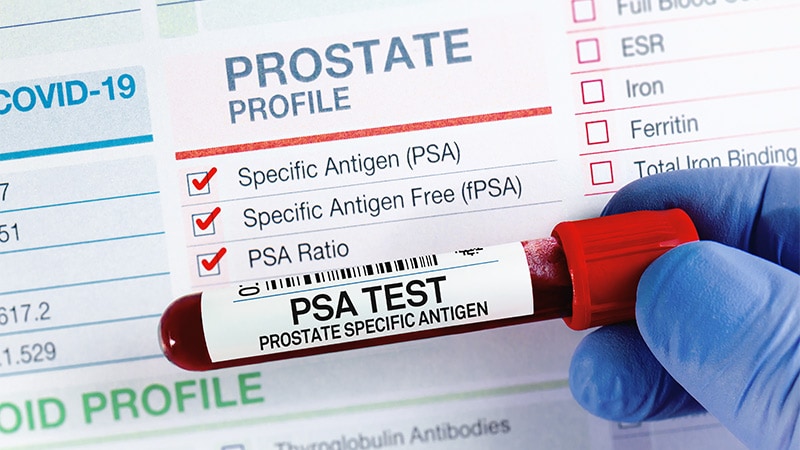Factors Predicting Time to PSA Failure in Prostate Cancer Patients
Główne pojęcia
Specific factors predict shorter time to PSA failure in prostate cancer patients.
Streszczenie
TOPLINE:
Baseline PSA of 10 ng/mL or greater, Gleason scores of 8 to 10, and younger age linked to shorter time to PSA failure.
METHODOLOGY:
Shorter time to PSA failure correlates with worse outcomes in prostate cancer.
Secondary analysis of a phase 3 trial identified factors associated with earlier recurrence.
Most patients had good performance status, median age of 66 years, and high Gleason scores.
TAKEAWAY:
PSA levels between 10 ng/mL and 20 ng/mL and Gleason scores of 8 to 10 associated with shorter time to PSA failure.
Older age linked to lower risk for PSA failure.
High-risk group defined by age, PSA level, and Gleason score had significantly higher risk of early PSA failure.
IN PRACTICE:
High-risk patients may benefit from treatment escalation with specific therapies.
Younger age in high-risk category important for clinical risk prediction.
SOURCE:
Study published in JAMA Network Open with commentary by Martin Schoen, MD, and Charles Bennett, PhD.
LIMITATIONS:
Results are hypothesis-generating and should be validated in new cohorts.
Study enrolled mostly White men.
DISCLOSURES:
Study had no commercial funding and authors report no relevant financial relationships.
These Factors Predict Shorter Time to PSA Failure
Statystyki
Baseline PSA of 10 ng/mL or greater, Gleason scores of 8 to 10, and younger age linked to shorter time to PSA failure.
PSA levels between 10 ng/mL and 20 ng/mL and Gleason scores of 8 to 10 associated with shorter time to PSA failure.
Older age associated with a lower risk for PSA failure.
High-risk group had a significantly higher risk of early PSA failure.
Men who received pelvic radiation therapy had a significantly lower risk for PSA recurrence.
Cytaty
"Men in the high-risk group had a significantly higher risk of early PSA failure compared with men in the low-risk group."
"High-risk patients may benefit from treatment escalation with androgen receptor signaling inhibitors or cytotoxic chemotherapy."
Kluczowe wnioski z
by Megan Brooks o www.medscape.com 10-16-2023
https://www.medscape.com/viewarticle/997404
Głębsze pytania
What are the implications of these findings for prostate cancer treatment strategies
The findings of this study have significant implications for prostate cancer treatment strategies. Identifying factors such as baseline PSA levels, Gleason scores, and age that predict shorter time to PSA failure can help clinicians personalize treatment plans for patients with nonmetastatic unfavorable-risk prostate cancer. For instance, patients identified as high-risk based on these factors may benefit from treatment escalation with androgen receptor signaling inhibitors or cytotoxic chemotherapy. This targeted approach can potentially improve outcomes by addressing the specific characteristics associated with early PSA failure, leading to more effective treatment strategies and better patient outcomes.
How might the study results be influenced if the cohort included a more diverse population
If the cohort included a more diverse population, the study results could be influenced in several ways. A more diverse population would provide a broader representation of patients with different genetic backgrounds, lifestyles, and healthcare access, potentially leading to a better understanding of how these factors impact PSA failure in prostate cancer. Additionally, including a diverse population could help identify any disparities in treatment outcomes among different demographic groups, leading to more equitable and inclusive treatment strategies. However, it is essential to ensure that the study results are generalizable across diverse populations to effectively inform clinical practice and improve patient care for all individuals with prostate cancer.
How can the identification of high-risk patients impact the overall prognosis and treatment outcomes in prostate cancer
The identification of high-risk patients based on factors such as younger age, higher PSA levels, and Gleason scores can have a significant impact on the overall prognosis and treatment outcomes in prostate cancer. By recognizing these high-risk individuals early on, clinicians can tailor treatment plans to address their specific needs and potentially prevent or delay PSA failure. High-risk patients may require more aggressive treatment approaches, such as targeted therapies or combination treatments, to improve their prognosis and outcomes. Additionally, identifying high-risk patients allows for closer monitoring and follow-up, which can lead to earlier detection of disease progression and timely intervention. Overall, the identification of high-risk patients can help optimize treatment strategies, enhance patient outcomes, and ultimately improve the overall management of prostate cancer.
0
